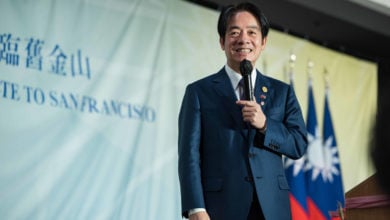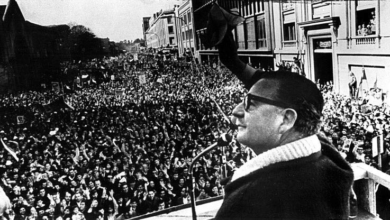On October 1, 1949, Mao Zedong declared an earth-shaking victory: the Chinese Communist Party had prevailed in the country’s long civil war and China was now a People’s Republic committed to the construction of socialism. Those still loyal to the reactionary, pro-imperialist Kuomintang party led by Chiang Kaishek fled to Taiwan. China and the world are now marking the 70th anniversary of this milestone that changed the course of history.
Ending the “century of humiliation”
Just ahead of the famous October 1 declaration, Mao told delegates to a summit of top leaders from across the country, “We have closed our ranks and defeated both domestic and foreign oppressors through the People’s War of Liberation and the great people’s revolution, and now we are proclaiming the founding of the People’s Republic of China … Ours will no longer be a nation subject to insult and humiliation. We have stood up.” Beginning with the first Opium War in 1839, China’s sovereignty was uprooted by imperialism for over a century. The British waged this war of aggression in response to the Chinese monarchy’s prohibition on British opium imports into China, which were causing a massive addiction epidemic.
China was defeated. What began as five open “treaty ports” to be controlled by the British became countless foreign-dominated ports to be exploited by many different imperialist powers. China endured invasions by the Japanese empire, border disputes with Czarist Russia and the secession of areas once part of its territory. Known as the “Century of Humiliation,” China went from being one of the most advanced civilizations, producing 30 percent of the world’s economic output, to a state of serious under-development, colonialism, warfare and domestic instability.
The Chinese Communist Party’s victory on October 1, 1949, put an end to the Century of Humiliation, liberating the Chinese people from imperialist strangulation. The People’s Republic of China was established, thus beginning the path towards socialism.
China and the world anti-colonial movement
The people’s victory in China took place in the context of the emerging global class war known as the Cold War. The Chinese Revolution was not only a socialist revolution, it was a national liberation struggle. This triumph was a victory for all independence and socialist struggles around the world, and electrified global politics.
Because such a huge and important country had joined the Soviet Union in the socialist camp, the balance of world power began to tip away from the imperialists. The U.S. ruling class went into a state of panic, and the scramble began to determine the arrogant and racist question “who lost China?” This became the opening act of the McCarthyist “Red Scare” witch hunt.
In addition to the inspiration the Chinese revolution provided to freedom fighters around the world, the formation of the People’s Republic also represented a source of material aid for struggles around the world for independence and socialism. During the Korean War, for instance, hundreds of thousands of Chinese soldiers fought alongside their Korean brothers and sisters with Soviet weaponry against the U.S.-led invading armies.
China also played a key role as a trading partner for newly-independent nations, providing a desperately-needed alternative to the markets of the imperialist countries. In 1961, Kwame Nkrumah, president of Ghana, negotiated an interest-free loan from China. The deal included the exchange of industrial and agricultural experts involving the training of Ghanian workers in China. This is just one of the many examples of cooperation between nations on the basis of development, rather than predatory relationships based on exploitation.
The Chinese Revolution also inspired radical organizations in the United States itself. The Young Lords, formed in the late 1960s, fought for the end of U.S. colonialism in Puerto Rico as well as the oppressive conditions and systematic racism faced by Puerto Ricans in the U.S. mainland. The Young Lords studied the defeat of the Japanese and then the defeat of the Kuomintang by the Chinese Communist Party as well as how the Chinese revolutionaries began to undo the patriarchal norms that subordinated women.
Like the Soviet Union, the People’s Republic of China extended solidarity with the African American struggle in the United States. Not only did Mao meet with legendary African American freedom fighter W.E.B. Du Bois, but Chinese Premier Zhou Enlai met with Black Panther Party leader Huey Newton. Regular study of the works of Mao Zedong were common practice among many radical groups of the era. One of the most well known fundraising efforts by the Black Panther Party was selling Mao’s “Little Red Book” on college campuses, and this text was required reading for all members.
Laying the basis for rapid growth
After taking power in 1949, the Chinese Communist Party faced two enormous challenges: developing China to overcome the poverty that its people endured and transforming relations in society to empower the working class and peasants who composed the overwhelming majority of the population. Throughout the course of China’s revolution the Communist Party adopted a wide range of often contradictory methods and strategies to accomplish these tasks. While much remains to be done, an examination of how far China’s society has progressed 70 years after the revolution reveals one of the greatest transformations in human history.
One of the most notable early efforts was the Great Leap Forward, China’s second five-year plan, which laid the basis for rapid development in future years while radically reorganizing production in Chinese society. The Great Leap Forward was an ambitious attempt at rapid agricultural and industrial development. At the time, China’s lack of modern infrastructure meant that more common forms of production where certain products were produced mainly in urban centers and then transported into all other areas posed a huge challenge. In an attempt to remedy this, communes were established all throughout rural parts of China for both agricultural and industrial production. Major irrigation systems were constructed and water conservation projects would later protect China from unpredictable weather conditions.
While critics of the Great Leap Forward deem it a huge failure resulting in astronomical famine-related deaths, many demographers and historians challenge this narrative today. There were periods of short term food shortages, mostly due to the reorganization of production, but also three consecutive years of unforeseeable harsh weather conditions.
This undertaking required the entire mobilization of the rural population to partake in labor-intensive work, and the leadership of the Chinese revolution did reflect on errors made in relying on extraordinary human effort to overcome material underdevelopment. However, the infrastructure established during that time enhanced long term agricultural output, something that is essential for industrialization. Studies show that the per hectare yield of land sown with food crops increased by 145.9 percent and total food production rose by 169.6 percent during the 1949 – 1978 period. Industrial production increased by an annual average of 11.2 percent from 1952 -1976. Socialist economic policies paved the way for rapid growth during the post-Mao era.
Women’s liberation
Foot binding, female infanticide, wife-beating and other forms of subjugation were routine experiences of women prior to the revolution. After the revolution, the Basic Law established in the People’s Republic of China stated:
“The People’s Republic of China shall abolish the feudal system which holds women in bondage. Women shall enjoy equal rights with men in political, economic, cultural, educational and social life. Freedom of marriage for men and women shall be put into effect” (Article 6).
Arranged marriages, concubinage and child marriages were abolished. There was an upsurge of divorces initiated by women.
Women were also encouraged to join the workforce. During the Great Leap Forward, communal kitchens, kindergartens and nurseries were formed so that women could participate in the massive development projects. Close to 5 million nurseries and kindergartens and more than 36,000,000 dining halls were set up in rural areas by 1959.
The educational policy and literacy campaign was yet another huge undertaking of the People’s Republic. In a mere 10 years, China’s illiteracy rate went from 80 percent to 43 percent – even in the rural areas. This meant teaching hundreds of millions of people how to read and write.
U.S. imperialism tries to stop China’s rise
As poverty continues to increase in the United States, poverty has steadily decreased in the People’s Republic of China. More than half a billion people were lifted out of extreme poverty between the years 1981 and 2004. China’s GDP increased, on average, 10 percent per year, and lifted more than 800 million people out of poverty.
China took a sharp turn in economic development by introducing market reforms in 1978, creating a capitalist class and exacerbating class conflict and inequality within Chinese society. Many progressive people view this as an end to the socialist country that they once found inspiration in. The Party for Socialism and Liberation views this as a mistake — while the turn to capitalist methods of development comes with great political dangers, there has been no counter-revolution in China. The state that governs China is a product of a workers’ and peasants’ revolution, and that state is able to direct and control the capitalist class as it sees fit.
In recent years, the leadership of the Chinese Communist Party has taken a leftward turn in its political orientation in the face of heightened U.S. imperialist aggression. In 2013, China introduced a trade initiative called One Belt, One Road, now more commonly referred to as the Belt and Road Initiative. This project would span from East Asia to Europe, establishing relationships based on peaceful diplomacy and trade among these nations. Over 60 countries made up of two-thirds of the world’s population have signed onto this project. This would put China at a geopolitical advantage as an emerging world power, rivaling the United States.
The ongoing U.S. trade war against China makes it clear that the U.S. government is more interested in destabilizing China even at the cost of the economic well-being of its own population. China does not want conflict with the United States, but it is increasingly ready to do what it needs to defend itself.
Every socialist experiment is a product of both the historical and material circumstances a society finds itself in as well as the decisions of the revolutionaries who aim to transform the society to meet the needs of the people. In just a short 70 years, China has made enormous strides towards the eradication of poverty, the modernization of its economy and infrastructure, and the creation of a world order where the imperialist nations of the west do not have unchallenged domination of global politics. The people’s triumph of 1949 is what set this into motion.





